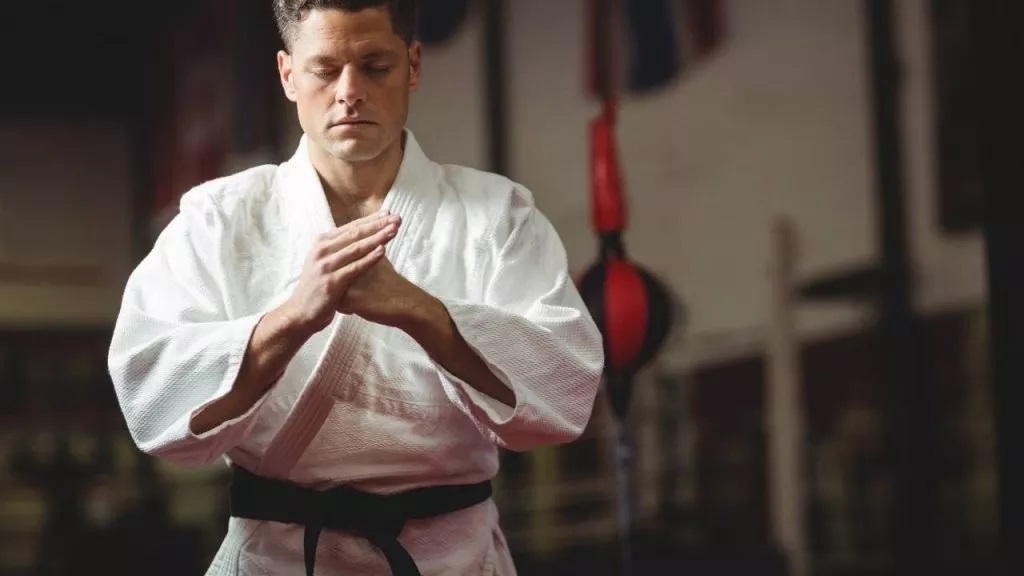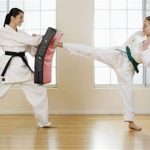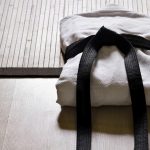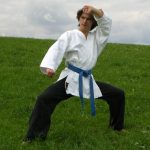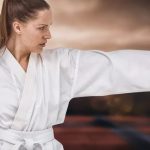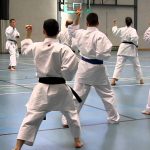The principles of karate come from its Japanese origins.
They apply to all forms of karate, including conventional and non-traditional styles. The principles can be used to improve one’s understanding of karate and progress towards his or her goals in training.
So, what are the twenty guiding principles of karate? Karate is a type of martial art that emphasizes self-defense through punching and kicking.
It also has many different forms, such as sumo, karate, and taekwondo. Karate was first made in China more than 500 years ago. In the 19th century, it was brought to Japan.
By the way, karate isn’t just for self-defense; it’s fun to do and keeps you in shape!
The Twenty Guiding Principles of Karate
In Your Pursuit Of The Way, Remain Constantly Mindful, Diligent, And Resourceful.
You must always improve on yourself in order to be the best you can be at whatever you are doing in life.
Karate is not a competitive sport; rather, it is a means of self-improvement through the practice of physical and mental discipline.
It evolves with each individual; everyone progresses at their own pace.
Do not overlook the use of power withdrawal, body extension or contraction, or the quick or leisurely application of technique.
Your opponent doesn’t have to know exactly when you’re going to strike, so you should use your skill instead of your strength.
You will sometimes faint a “power punch” by letting your fist sink lower into your palm before striking; this is called the “sinking fist” technique.
Similarly, not every strike needs to be delivered with full force; sometimes it is better to deliver a power strike with restraint; this is called “forceless force” or “soft power.”
Execute Kata Precisely; Actual Combat Is a Different Story.
Kata may be described as a means of familiarizing oneself with the essentials of self-defense without weapons. It can also be thought of as a kind of fighting where there is no opponent and no physical force is used.
You must not only control the movements of your body but also control your mind. You must be focused and calm in order to execute a technique perfectly and avoid injury to yourself or others.
Kata, on the other hand, is practiced as a series of predetermined movements done at a slow pace to master and perfect them. The movements are done in a precise way so that the techniques can be done correctly at any time without hesitation or error.
Formal Stances Are for Beginners; Later On, One Stands Naturally.
Beginners are taught posture so that they will be less likely to fall over; advanced students stand naturally without thinking about it.
Beginners don’t need formal stances once they’ve mastered the basics and are good enough at what they’re doing. Instead, they can move on to a more natural stance that can be held indefinitely.
You Face A Million Enemies When You Leave Your Own Gate
When you go out, you must be prepared to defend yourself against anything—not just physical attacks but also verbal assaults, social intimidation, sexual harassment, and even economic exploitation.
We don’t just have to worry about physical attacks from other people. In everyday life, we can also experience mental stress from overwork and pressure, which can lead to nervous exhaustion and physical collapse.
However, you should be aware of your own limitations. Stop and take a break if you start to lose your balance. Only then should you keep going.
Consider Your Hands and Feet to Be Swords.
This is one of the twenty guiding principles of karate’s most combat-defining principles.
Your hands and feet should be thought of as swords—not literally but in the sense that they are powerful weapons that can be used to inflict damage upon an attacker or to defend himself against an attack.
Just as we can hack and cut flesh with our hands, we can inflict pain on an opponent with our hands and feet.
The Outcome of a Battle Is Determined by How Well One Handles Emptyness and Fullness.
When your opponent tries to avoid your attack, you should be certain to counter with your own move.
When he attempts to strike you, be sure to dodge out of the way and then counterattack—this is called empty and full.
Similarly, if somebody is blocking you with his body and pushing you back, you should strike at that part of the body; this is referred to as the “three-quarter” technique.
Don’t challenge what you cannot win. Rather, confront your opponent from a position of strength: when the opponent is weak, take advantage of that weakness to beat him.
Instead, improvise and use your ingenuity to deal with any unexpected situation.
When you don’t know what you should do next, surprise your enemy by attacking him unexpectedly.
Make Changes Based On Your Opponent
Just as our everyday interactions with other people put us in a lot of different situations where we have to change how we act, so must we change how we fight depending on the situation.
In the same way, we can’t use the strategies and moves of traditional karate to fight thugs or gangsters today without making things worse.
Consider Not Winning, but Rather Not Losing.
The primary purpose is to avoid defeat, not to win every battle or competition you encounter.
If you’re constantly focused on winning, you may forget why you’re fighting in the first place, which is to defend yourself and others against violent criminals and terrorists who are intent on causing harm to others.
Your opponents will eventually come up with a reason to stop fighting. If that happens, you’ll have to fight even harder to keep them from getting away with your honor still intact.
Karate Is Similar to Boiling Water in That Without Heat, It Returns to Its Tepid State.
In the world of karate, “heat” refers to the “fighting spirit” that we build up through our training.
When we apply that “heat” to our training, it gives rise to a new type of energy within our bodies.
If the karateka takes a meal break in the middle of training, he will lose his fighting spirit until he takes another meal break later and gets it back.
The art goes beyond the dojo and into the streets. Because of this, we must train constantly to keep our “fighting spirit” at a high level.
Apply the Karate Method to Everything.
Karate is more a way of life than merely a martial art. As such, we must apply the principles and concepts of the art to everything we do in our lives, including eating, sleeping, and working.
It’s a way to bring order out of chaos by channeling our natural energies into a systematic method of self-improvement and control of our physical beings.
The lessons must be practiced diligently until they become a part of you; otherwise, you will lose them as soon as you encounter a problem or opportunity that requires you to recall them.
Even while dancing, you can remember your technique and thus improve it.
You must always be respectful, whether you’re inside or outside of the dojo; likewise, you must behave in the same manner inside and outside of the dojo as well.
Discipline must also extend beyond the walls of the dojo. A martial artist must learn self-discipline before he can hope to achieve true martial skill.
Karate Is A Lifetime Interest
Karate is an art that, if done right and with dedication, can help you learn and grow for the rest of your life.
We do not merely practice karate for the sake of exercise or self-defense. Rather, we seek to understand both the physical and philosophical principles behind the art and then apply them to every aspect of our lives.
Beyond the Dojo: Karate
Karate emphasizes the need for mental as well as physical discipline; as such, the practitioner must also be mentally disciplined in addition to physically disciplined.
These values are not just meant to imply a calm and level-headed demeanor: While calm and level-headedness are certainly desirable qualities to have, this doesn’t mean we should be completely emotionless and devoid of all feelings.
Carelessness Causes Disaster
Whether it is negligence in driving a car or carelessness in practicing martial arts, the result is often the same: disaster.
It should be the goal of every martial artist to learn to control his body—both its outward appearance and its internal functions—so that he is always in complete control of his physical and mental faculties.
Otherwise, it will quickly become apparent that he has no control over either his physical body or his mental state – two attributes that are necessary for achieving a high level of martial arts skill.
The Heart Must Be Released
Free your heart of prejudices, hatreds, jealousies, and all other negative emotions that prevent you from achieving inner peace and happiness.
Your goal should be to find meaning in your life by practicing karate and living according to your values and beliefs.
We cannot be dominated by either fear or anger.
Instead, we need to let go of these feelings and learn how to put them to good use so we can do our jobs and reach our goals with courage and determination.
Gichin Funakoshi came up with ideas in martial arts like “ki” (energy) and “kara” (empty hand) that Shotokan karate practitioners all over the world still study today.
Mentality Trumps Technique.
The mind must come before the technique; you can’t hope to master a technique until you’ve mastered the mental parts of it.
Whether you use your verbal skills to convince your opponent of your prowess or simply by showing him that you are not to be trifled with, confidence plays a big part in the outcome of a fight.
To master an art and live a full life, you should practice everything with a calm, focused mind that is determined to get past any problems.
Know Yourself First, Then Know Others
Understanding karate is important for becoming a proficient martial artist.
However, the more important aspect is to understand yourself first so that you can become the best person you can be and then help others become the best they can be as well.
You won’t be able to help others unless you are able to help yourself first, so you must first know yourself before you can know others.
Karate Supports the Rule of Law
This is an essential guideline among the tenets of Shotokan karate: to live by the law and not violate it under any circumstances.
Karate is always used to show how important it is to listen to authority and follow the rules.
In fact, this martial art is a great way for young people to learn how to follow the law and respect the rights and freedoms of others.
We must speak out for what is right and against what is wrong at all times, even when it is unpopular to do so.
In Karate, There Is No First Strike.
This means that people who practice karate don’t start fights with other people. Instead, they try to solve problems peacefully through talk or compromise.
Of course, that won’t be the case in every situation, but it is important to always consider peaceful means of resolving conflicts before resorting to violence or intimidation.
This rationale may also extend to other aspects of our lives where we may need to confront someone who is in the wrong.
For example, it might be better to try to work out a problem with someone in a business setting before confronting them directly, which could make things worse in the long run.
Beginners, in particular, must understand that in karate training, everyone, regardless of rank, learns the same techniques at roughly the same time.
Remember That Karate Begins and Ends With Rei.
Rei is the bow that karateka use to honor their teachers and show respect for themselves and their fellow students before and after training.
To me, this one concept encompasses all the important parts of karate training: it teaches us humility and respect for others.
It reminds us of our obligations to our community, and it reminds us to continue striving to improve ourselves so that we can reach our full potential.
You will end up taking the lessons you learn in the dojo into your daily life so that you can become a better person and reach your full potential as a human being.
Also Read: Okinawan Karate Styles
Final Words
The Shotokan karate book goes into great detail about the history and philosophy of this martial art. It is also a great resource for both new students and instructors who want to learn more about Shotokan karate’s traditional techniques.
The niju kun (20 Karate Precepts) is a timeless document that teaches its readers how to live by example, respect others, strive to achieve one’s goals in life, and be charitable to those in need.

